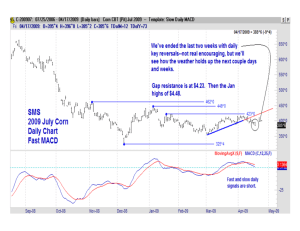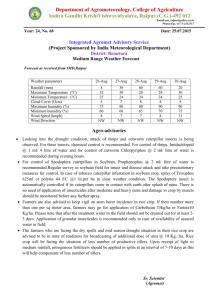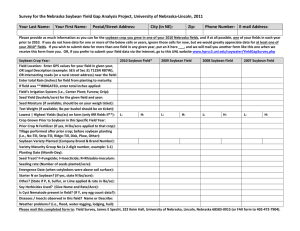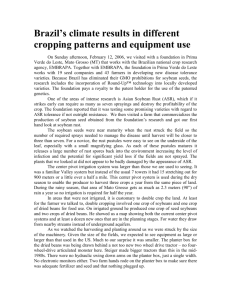In August of 1972,1 wrote a soybean price outlook paper... look Conference. Fortunately, it has been lost. Fortunately because it...
advertisement
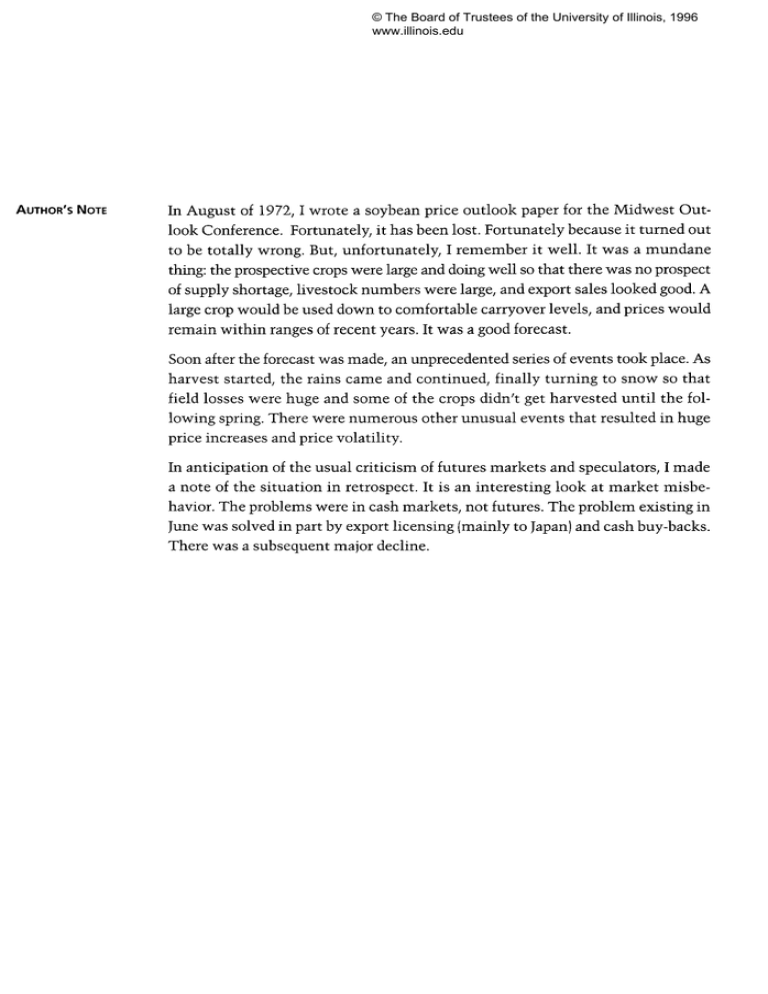
© The Board of Trustees of the University of Illinois, 1996 www.illinois.edu AUTHOR'S NOTE In August of 1972,1 wrote a soybean price outlook paper for the Midwest Outlook Conference. Fortunately, it has been lost. Fortunately because it turned out to be totally wrong. But, unfortunately, I remember it well. It was a mundane thing: the prospective crops were large and doing well so that there was no prospect of supply shortage, livestock numbers were large, and export sales looked good. A large crop would be used down to comfortable carryover levels, and prices would remain within ranges of recent years. It was a good forecast. Soon after the forecast was made, an unprecedented series of events took place. As harvest started, the rains came and continued, finally turning to snow so that field losses were huge and some of the crops didn't get harvested until the following spring. There were numerous other unusual events that resulted in huge price increases and price volatility. In anticipation of the usual criticism of futures markets and speculators, I made a note of the situation in retrospect. It is an interesting look at market misbehavior. The problems were in cash markets, not futures. The problem existing in June was solved in part by export licensing (mainly to Japan) and cash buy-backs. There was a subsequent major decline. © The Board of Trustees of the University of Illinois, 1996 www.illinois.edu NOTE ON THE SOYBEAN PRICE AND SPECULATION The price of 1972-crop soybeans has gyrated wildly for some months, mostly upward, and has reached levels without precedent and higher than seems believable. It appears to be a level which cannot be sustained by consumption demand for end products, meal in particular. Intra-day price ranges are very large, reaching $1.00 on June 5. Abnormal demand forces appear to be in operation. The price action in old-crop soybeans appears to be having an impact on newcrop soybean prices, pulling them to levels higher than would otherwise prevail. Old crop prices are disruptive of the orderly movement of limited supplies into con- sumption; they are also disruptive of the orderly achievement of a productionuse balance for the 1973-74 crop year as well. Some appraisal of the reasons for the dynamics and an offering of suggestions for quieting the market down seem a reasonable exercise. The market has done a remarkably bad job of discounting all the price-making forces into the current price in a way which would hold price variations within a reasonable range for the season. What went wrong? Three principal factors are involved. First, it appears in retrospect that the market had an extraordinarily difficult task. The supplies were not only unknown at the outset of the season but also remain unknown even now. Further, reasonable supply estimates changed as the season progressed. The production of fish meal (the principal competitor of soybean meal) started in the fall season and was suspended. It was again started with excellent results in March but was re-suspended in April. What appeared to be a very highyielding soybean crop was severely damaged by heavy rains in October and subsequent abnormal weather. There is a major and as yet unresolved discrepancy between the crop estimate minus known disappearance and the April 1 stock report. The market could not reasonably be expected to know how fast it could prudently allow the use of protein supplies when it did not know what those supplies were. There appears to have been an unusually large increase in demand. This was prob- Paper prepared on June 5, 1973. 269 CHAPTER 30 © The Board of Trustees of the University of Illinois, 1996 www.illinois.edu ably the result of rapidly increasing economic production and consumer incomes that increased the demand for livestock products, hence, for food, hence, for protein supplements. On a world scale, anticipating and appraising the impact of the demand changes as they worked through the system was extraordinarily difficult. The amounts of both supply and demand changes were outside of historical experience, which added to the difficulty of measuring their impact, to put the matter mildly. A further addition was a series of changes in the relative values of currencies. The U.S. dollar was twice devalued and currencies were allowed generally to float. And there was an increase in the worldwide rate of inflation. In the face of this extraordinary set of difficulties, a large fluctuation in prices is not surprising. Second, imperfections in the pricing system have likely contributed. These are in the nature of lags in registering current market prices at the consumption level. It has been, and is, necessary to reduce soybean meal use from optimum proteincarbohydrate balance in rations and to restrict or reduce animal numbers. Feeding was quite profitable early in the season, and consumption was at quite high levels. It was, and is, necessary to reduce use from early season levels. Price, and price alone, can do this. But, price can be effective only as it operates at the consumption level. In the United States, feed manufacturers do a fairly good job of keeping feed prices current with replacement costs of ingredients. But, to some extent, they do buy ahead and do fail to increase feed prices fully as fast as ingredient prices rise. In soybean and meal destination countries, forward cover of requirements is much more extensive, and feed prices are not kept current with replacement cost of ingredients. There is extensive vertical integration, from importer to processor, to feed manufacturer, to livestock producer, and to livestock and poultry buyers. Long-term contracts were made in the summer of 1972 for animals and poultry to be delivered in early spring of 1973, and costs, soybean meal in particular, were covered at the then-existing prices. In France, there is a system of ceiling prices on mixed feed which is based on ingredient costs. It is changed only as actual cost of ingredients changes. Ceilings were established early in the summer of 1972 and ingredients requirements covered through as late as May 1973. Thus, high meal prices have simply not existed at the consumption level for much of the market. Third, the soybean futures market for contracts relating to the 1972 crop (November 1972 through September 1973 maturities) has been underspeculated. The level of speculative participation has been low, and this has contributed to the violent price variations and poor job of discounting new information into the price. 270 © The Board of Trustees of the University of Illinois, 1996 www.illinois.edu The single meaningful measure of speculation is the number of open contracts, not (as is often thought) the volume of trading. It is positions taken that is significant. For the past three years, the May 31 open interest by contract was in millions of bushels. TOTAL NEXT CROP YEAR JULY AUGUST SEPTEMBER TOTAL OLD CROP 1971 68.9 35.8 27.2 131.9 1972 106.1 43.1 16.8 166.0 151.4 1973 40.4 27.8 15.3 83.1 211.1 128.4 In spite of price volatility, open interest in old-crop positions was relatively small at the end of May. This, in part, reflects the small inventory, but it also reflects a relatively low level of speculative interest. Positions pertaining to the 1973 crop were unusually large (of record size by far) at the end of May. This reflects forward purchases, particularly exporters, and forward sales by farmers in response to high prices. The structure of the open interest is more revealing. Each market participant who has a position of 200,000 bushels or more is required to report daily to the Commodity Exchange Authority and declare whether he is a hedger or a speculator. If a hedger, he must show the offsetting cash position. People whose positions are smaller than 200,000 bushels are identified as "nonreporting traders," and their positions are derived from those of hedgers, speculators, and the total open interest. Special cross-section studies indicate that the bull—say, eighty to ninety percent of nonreporting traders are speculators. These are the speculating public. The positions of the three categories on April 30 for three years were in millions of bushels (net open being total open interest minus reported spreads). Unfortunately, the data are not reported by crop years. NON-REPORTING TRADERS SPECULATION HEDGERS NET SHORT NET LONG SHORT 118.1 97.3 +20.8 15.0 15.9 -0.9 59.7 79.6 -19.9 192.8 104.7 128.6 -23.7 14.6 14.5 +0.1 128.1 105.0 +23.9 247.6 172.4 155.0 +17.4 18.4 20.9 -2.5 54.6 69.5 -14.9 245.5 YEAR LONG 1971 1972 1973 NET LONG SHORT NET OPEN PERCENT OF N E T OPEN INTEREST 1971 63.1 50.5 7.8 8.2 31.0 41.3 1972 42.4 51.9 5.9 5.9 51.7 42.4 1973 70.2 63.1 7.5 8.5 22.2 28.3 The thing of particular note is that the proportion of the open interest held by commercials, both long and short, is unusually large. (In passing, it is worth not- 271 © The Board of Trustees of the University of Illinois, 1996 www.illinois.edu ing that, going into the very rapid price rise in May, both reporting speculators and the public were net short. This has been typical of the crop year as a whole.) Without confirming data, I think that were the old and new crop structures to be separated, the percentage held by commercials would be even larger. Commercials are not price-responsive; speculators are. The long positions held by hedgers are of two main types: processors long against sales of soybean oil and meal and exporters long against cash soybean sales. They have firm commitments into consumption, generally at very much lower prices. The rising price of soybeans in no way encouraged them to sell; they are not affected except as futures profits generate large cash balances. The short positions held by hedgers are presumably against physical inventories of soybeans that have not yet been moved into consumption positions. What they lose on futures is gained on the cash inventory, so that the only effect is on cash balances they must post as margin as prices rise. Note that hedgers were net long. The speculators are necessarily net short. They have no way to get out of the short position except as hedgers complete cash transactions and leave the futures market. Individual speculators can get out, but only as they can find others to take their places. Speculators are responsive to price changes. Different speculators respond differently, and how they respond is not known. When speculators are active, they have a cushioning effect on price change. A rising price brings out profit-takers and vice versa. A price change doesn't accomplish anything if only commercials are in the market. The longs stay in even though they think the price is too high. Losses of shorts do not force them out because they have offsetting profits. When cash interest has to meet cash interest, in futures, prices become quite volatile. These three things explain the reasons for extreme volatility of price and how we got where we are. They do not point to the ultimate outcome nor to a solution of the problem. We shall probably never know the nature of the impasse or how it is solved. There appears to be a strong possibility that the soybean supply has been oversold, that more cash soybeans have been committed to use than actually exist. Some cash commitments are offset by physical possession and others by cash commitments to receive and buy. Clearly, the commitments by hedgers in futures to buy and take delivery are greater than those to sell and make delivery. The difference is the net short position of speculators. In the ordinary course of events, speculators would go to holders of uncommitted cash soybeans, buy, and make delivery to the long hedgers. However, it may be that there are not enough uncommitted cash soybeans to cover the difference. 272 © The Board of Trustees of the University of Illinois, 1996 www.illinois.edu The alternative is to buy back commitments. The only ways long hedgers can liquidate positions are to buy cash and to buy back commitments. Say that an exporter has sold cash soybeans for August shipment to a French processor, who has sold meal to a feed mixer, who has sold feed to a broiler producer, who has sold broilers for October delivery. There is a price at which the broiler commitments can be bought back, etc., so that the short can get loose. This is about the longest buy-back route, but it does illustrate the land of problem the market may face. Someone must give up soybean products that he has fully expected to use. Some price will do it. There is not only the price problem, but a communication problem as well. It may be that the exchange can facilitate the communication problem. If the hedgers' longs and shorts are identified, and the longs encouraged to buy back some commitments, the logjam can be broken. There is another side to this coin. It may be that the basic oversold amount may not be large, say 5 percent. The buy-back could easily exceed such an amount, and reach, say, 10 percent, before it became apparent. The market would then have inventory available for new commitments. It appears that there are not now, at current prices, new commitments. There is probably a big price gap between getting someone to give up a long-standing commitment and getting someone to make a new commitment for consumption. Should an over buy-back occur, there could be a price debacle. Most hkely, speculators would be accused of causing it. The essential point is that this is basically a commercial market, and the problem will be solved in cash markets. 273

